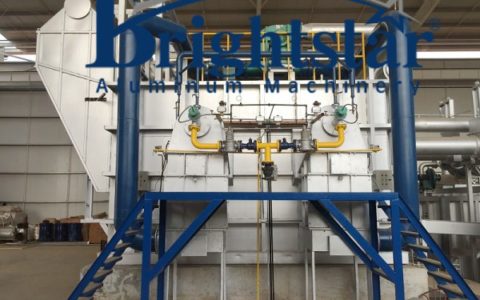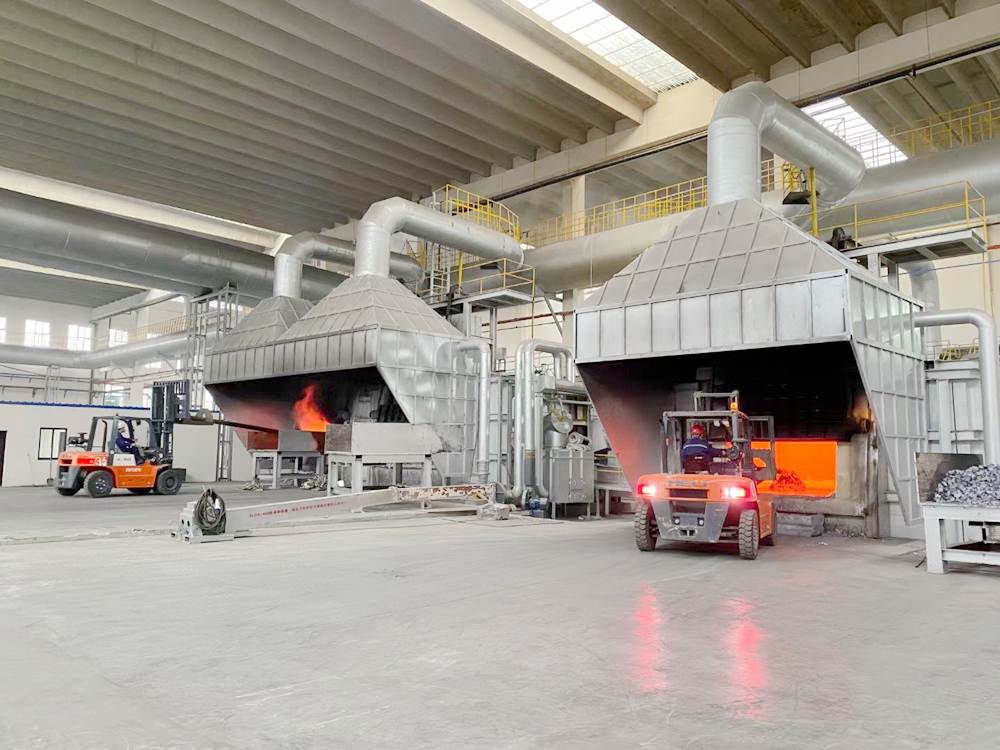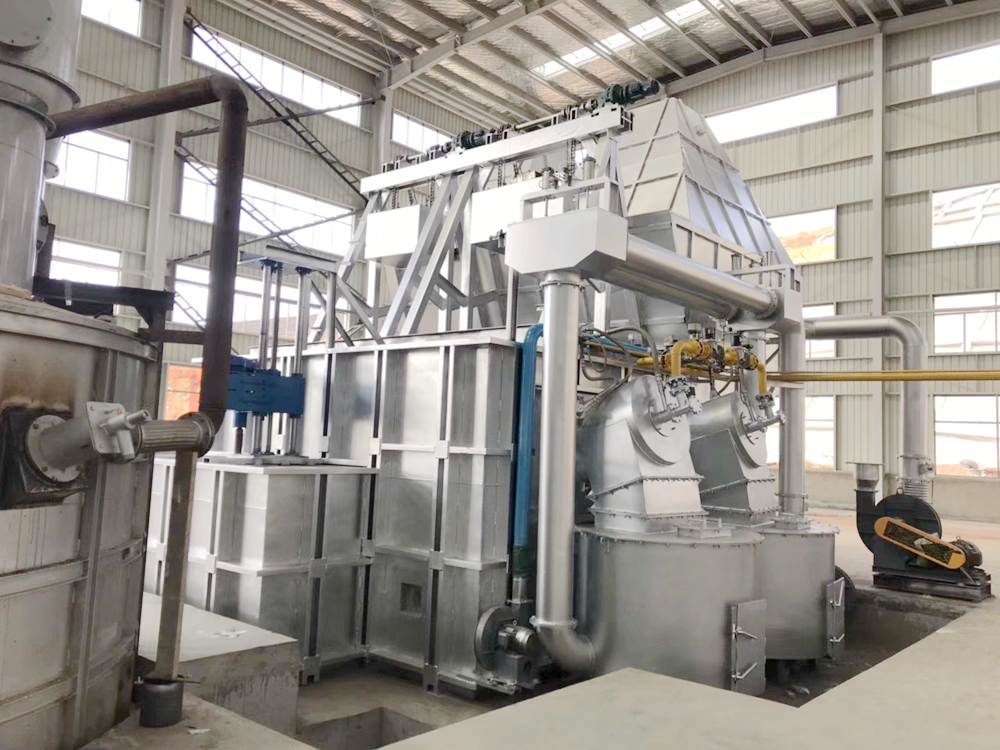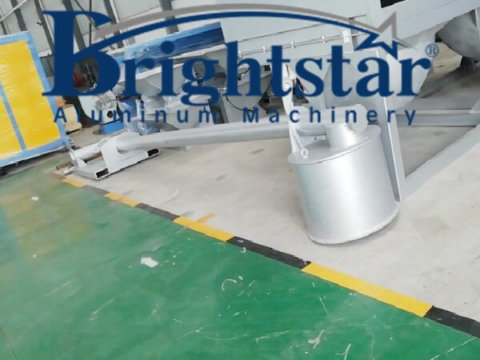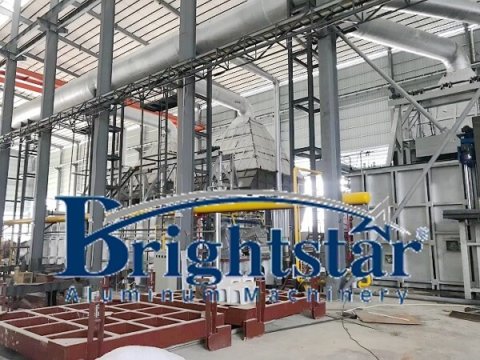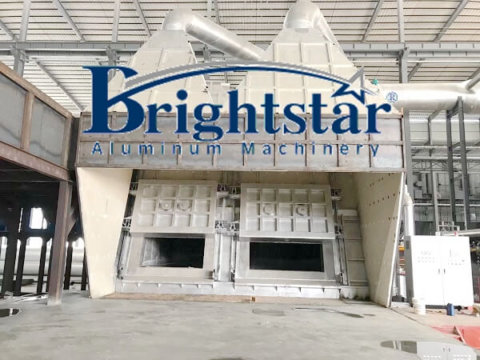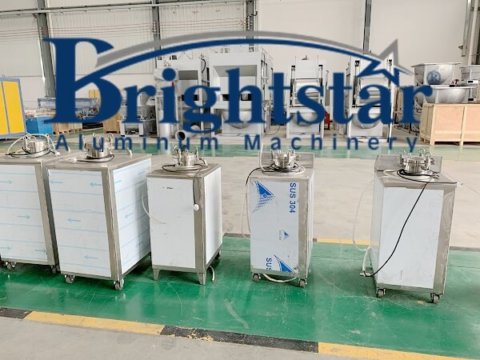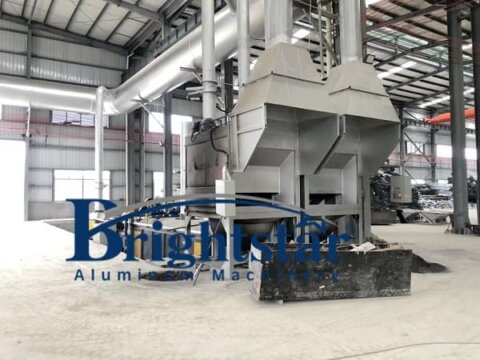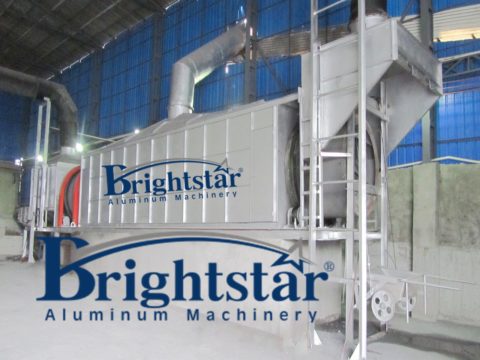
Regenerative aluminium melting furnace
Regenerative aluminium melting furnace
Regenerative aluminium melting furnace
What is regenerative aluminium melting furnace
The regenerative aluminum melting furnace is a type of furnace used in the aluminum smelting industry to melt aluminum scrap or raw materials for the production of aluminum ingots, billets, or other aluminum products.
The term “regenerative” refers to the furnace’s use of regenerative combustion technology, where heat from combustion gases is captured and reused to preheat incoming combustion air, resulting in improved energy efficiency.
Features:
1. Regenerative Combustion Technology:
The distinguishing feature of a regenerative aluminum melting furnace is its regenerative combustion system.
The furnace contains regenerative chambers filled with refractory material, which absorb heat from the outgoing flue gases during one phase of the combustion cycle.
This heat is then transferred to the incoming combustion air during the opposite phase, resulting in significant energy savings.
2. Refractory Lining:
Regenerative aluminum melting furnaces are lined with high-quality refractory materials capable of withstanding high temperatures and thermal cycling.
The refractory lining helps maintain optimal furnace performance and prolongs the furnace’s service life.
3. Dual-Chamber Design:
These furnaces typically feature a dual-chamber design, with two regenerative chambers alternately operating as combustion chambers and heat exchangers.
This cyclic operation allows for continuous melting and efficient heat recovery.
4. Burners and Combustion System:
Regenerative furnaces are equipped with high-efficiency burners and combustion systems designed to maximize heat transfer and combustion efficiency.
The burners are carefully calibrated to achieve uniform heating and melting of the aluminum charge.
5. Control System:
Modern regenerative furnaces are equipped with advanced control systems that monitor and regulate various parameters such as temperature, air/fuel ratio, and combustion efficiency.
This ensures optimal furnace performance, energy savings, and product quality.
6. Exhaust System:
An exhaust system is integrated into the furnace design to remove combustion gases and maintain proper ventilation.
Some regenerative furnaces may also incorporate pollution control devices to reduce emissions and comply with environmental regulations.
Advantages:
1. Energy Efficiency:
The regenerative combustion technology used in these furnaces significantly improves energy efficiency compared to conventional melting furnaces.
By capturing and reusing waste heat, regenerative furnaces can achieve energy savings of up to 50% or more, reducing operating costs and environmental impact.
2. Reduced Fuel Consumption:
The efficient combustion system and heat recovery mechanism of regenerative furnaces result in lower fuel consumption per unit of aluminum melted.
This not only reduces fuel costs but also decreases greenhouse gas emissions associated with furnace operation.
3. High Production Rates:
Regenerative furnaces are capable of melting aluminum at high rates, making them suitable for high-volume production environments.
The continuous melting process and rapid heat transfer contribute to increased productivity and throughput.
4. Improved Product Quality:
The precise control of temperature and combustion parameters in regenerative furnaces ensures uniform heating and melting of the aluminum charge, resulting in consistent product quality and metallurgical properties.
This is essential for producing high-quality aluminum ingots or billets for downstream processing.
6. Environmental Benefits:
The energy efficiency and reduced emissions associated with regenerative furnaces make them environmentally friendly compared to conventional melting technologies.
By minimizing energy consumption and emissions, regenerative furnaces help mitigate the environmental impact of aluminum smelting operations.
In summary, regenerative aluminum melting furnaces offer significant advantages in terms of energy efficiency, production efficiency, product quality, and environmental sustainability.
These furnaces play a vital role in the aluminum industry by enabling cost-effective and environmentally responsible melting of aluminum scrap and raw materials.
Main application
BS regenerative aluminum melting furnace is mainly used for solid aluminum, aluminum alloy ingot high temperature melting, aluminum liquid storage and high melting point alloy melting, but also for recycled aluminum melting and refining, especially used for the pre-melting in the manufacture of high-quality aluminum alloy rods, aluminum logs and aluminum plates, etc.
It is one kind of high efficiency and energy-saving environmentally friendly products.
Technical features and performance
1 Made up of rectangular furnace body, regenerative burner, mechanical lifting door, smoke exhaust system etc.
2 Furnace shell, bottom, outside reinforcement adopts GB high quality steel plate and steel welding.
The main working lining can be made of high alumina brick masonry, but also can be used non-stick aluminum castables; the other parts are made by relevant refractory materials, insulation material masonry.
3 Furnace door skimming parts adopts integral casting by superfine special casting for furnace door, can guard against long-term forklift charging and skimming impact and wearing for the furnace door.
4 Adopt automatic lifting furnace door, chain mechanical transmission device with electromagnetic brake motor with cycloid reducer, equipped with Anti-fall track and weight box. Design in ramp furnace door for the forklift operation convenience.
5 Each furnace will be equipped with 1 or 2 sets of the regenerative burner, the automatic control system through the touch screen, set the thermal parameters easily for the furnace; advanced industrial computer PLC automatically achieve the flame detection, flameout automatic protection, low voltage safety cut off, ignition program control, pulse combustion control, reversing control, temperature control, flow pressure control and other control procedures in the burning process.
1. Energy Efficiency:
Regenerative furnaces are highly energy-efficient compared to traditional melting furnaces.
They utilize regenerative combustion technology to capture and reuse waste heat from combustion gases, resulting in significant energy savings.
This is particularly advantageous in scrap recycling, where energy costs are a significant factor in the overall operation.
2. Reduced Operating Costs:
The energy efficiency of regenerative furnaces leads to lower operating costs for aluminum scrap recycling facilities.
By minimizing fuel consumption and energy usage, these furnaces help reduce production costs and improve profitability, making scrap recycling economically viable.
3. High Throughput and Productivity:
Regenerative furnaces are capable of melting aluminum scrap at high rates, allowing for increased throughput and productivity in scrap recycling operations.
This is essential for processing large volumes of scrap material efficiently and meeting customer demand for recycled aluminum products.
4. Consistent Product Quality:
The precise control of temperature and heating in regenerative furnaces ensures uniform melting of aluminum scrap, resulting in consistent product quality.
This is crucial for producing high-quality recycled aluminum ingots, billets, or other products that meet industry standards and customer requirements.
5. Environmental Benefits:
Regenerative furnaces offer environmental benefits by reducing greenhouse gas emissions and minimizing the environmental impact of aluminum scrap recycling.
The energy efficiency of these furnaces results in lower carbon dioxide emissions per unit of aluminum melted, contributing to overall sustainability and environmental responsibility.
6. Flexibility in Scrap Types:
Regenerative furnaces can effectively melt a wide range of aluminum scrap types, including clean scrap, contaminated scrap, and mixed alloys.
This flexibility allows scrap recycling facilities to process diverse feedstocks and optimize their operations based on available scrap sources and market demand.
7. Compliance with Regulations:
The energy efficiency and environmental benefits of regenerative furnaces help scrap recycling facilities comply with regulatory requirements and environmental standards.
By minimizing emissions and reducing energy consumption, these furnaces support sustainable and environmentally responsible scrap recycling practices.
8. Long-Term Cost Savings:
While the initial investment in regenerative furnaces may be higher than conventional furnaces, the long-term cost savings in energy consumption and operating costs justify the investment.
Over time, the reduced energy costs and increased productivity result in significant cost savings for scrap recycling facilities.
In summary, regenerative aluminum melting furnaces play a critical role in aluminum scrap recycling by offering energy-efficient, cost-effective, and environmentally sustainable solutions for melting and processing aluminum scrap into high-quality recycled products.
Main technical parameter of regenerative aluminium melting furnace
| Model |
BS10T |
BS20T | BS30T | BS40T |
BS50T |
BS70T |
|
| Outline dimension | Length | 2200 | 3000 | 3200 | 3500 | 3800 | 4800 |
| Width | 4200 | 5200 | 6400 | 7400 | 7800 | 8700 | |
| Height | 3450 | 3500 | 3550 | 3600 | 3650 | 3650 | |
| Capacity(ton) | 10+8% | 20+10% | 30+10% | 40+10% | 50+10% | 70+10% | |
| Furnace door size(mm) | 1600×1300 | 2000×1300 | 3000×1300 | 3500×1300 | 4000×1300 | 5000×1300 | |
| Burner model(104Kcal/t) | 250 | 300 | 350 | 200×2 sets | 250×2 sets | 350×2 sets | |
| Total power(Kw) | 40.5 | 60.5 | 92.5 | 149 | 178.5 | 224.5 | |
| Melting speed(t/H) | 2~3 | 4~5 | 5~6 | 6~7 | 7~8 | 9~10 | |
| Natural gas consumption(m3/t) | 60~65 | 65~70 | 65~70 | 65~70 | 70~75 | 70~75 | |
| Aoo aluminum ingot burning loss | ≤0.5% | ≤0.5% | ≤0.5% | ≤0.5% | ≤0.5% | ≤0.5% | |
Contact us now for your aluminum melting project, no matter aluminum scraps, aluminum chips, UBC, aluminum ingot or other raw materials, or the fuel is heavy oil, LPG, Natural gas.
We will offer the total solution for your aluminum melting project based on your production!
